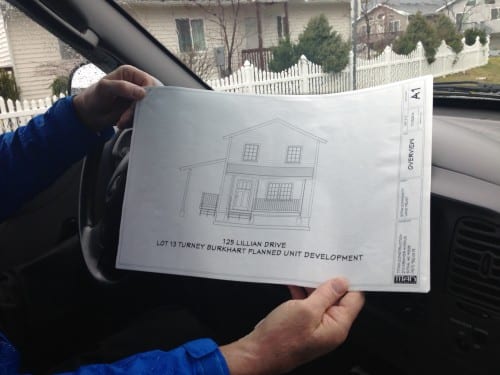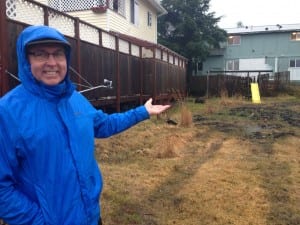
The 3-bedroom home will sell for around $250,000, far below the average sale price for homes in Sitka. (KCAW photo/Robert Woolsey)
It may be the cheapest route into a brand new family home in Sitka. But interest so far has been slow.
The Sitka Community Land Trust is ready to break ground on a new house in a quiet neighborhood. It will have two-stories, three bedrooms, a yard, and off–street parking. It will be among the most energy-efficient buildings in Sitka.
It has just about everything, in fact, except a long list of people eager to buy it.

Randy Hughey at the building site, which was previously platted as a “pocket park.” (KCAW photo/Robert Woolsey)
It’s a cold, wet day in late February and I’m standing in a vacant lot on Lillian Drive with Randy Hughey, a board member of the Sitka Community Development Corporation, and an evangelist for the Sitka Community Land Trust, which now owns this site.
I asked Hughey for a tour of the site, but the rain chases us inside the cab of his pickup truck.
Truck door slamming, engine starting.
A community land trust has been in the works in Sitka for several years. The assembly donated the lot last May, and the blueprints have been drawn up. But even though there’s the political will to move ahead with the project, there’s a problem.
“We need a buyer qualified to buy this house before we can proceed. We don’t have the means to finance this. We’re a little shoestring nonprofit.”
That buyer may have turned up finally. It’s a family of four — and we’ll go into how that family qualified in a minute. But this deal has been available literally for months. The sale price is $250,000 — that’s $165,000 below the average sale price for existing homes in Sitka last year — a discount of 40-percent.
But there’s a catch: You’re only buying the house — not the land. And you won’t be cashing in on the slow-but-steady growth in Sitka’s real estate market.
“When you sell the house, you don’t get to keep all the money. In order to preserve affordability across time, since land-home ownership tends to escalate in value far higher than incomes, when you sell this house you get to keep 25-percent of the difference between appraisals.”
The working idea behind a community land trust is that this 25-percent share of the equity in the home — if you live in it for a few years — should be enough to springboard you into the regular housing market. And the selling price of the house you’re leaving behind will be low enough for a family earning the Area Median Income — which currently stands at $78,000 — to buy its way in.
Simple, eh? But it’s not really taking root yet.
“It’s a mystery to us, frankly. We thought by the time we had a house like this — at a price like this — we’d have people lined up, and we just don’t.”
The SCDC’s requirements are not particularly strict: It wants a Sitka buyer — someone who already lives here, or is moving back to Sitka, or is moving here and plans to stay. And there’s also a financial threshold. A Community Land Trust home is not low-income housing in the traditional sense, and it’s not for the super rich. A family of four can’t have an income greater than $94,000.
Putting these pieces together — plus bank financing — took a while. But Hughey says this is perfect for professionals — like nurses or teachers — who might otherwise be stuck in Sitka’s pricey rental market.
“This is a way out of that. It doesn’t take federal funding and programs, or state housing or programs. It’s a totally local and simple model.”
And a model that the Sitka Community Land Trust would like to grow into a portfolio of affordable properties. Hughey envisions a neighborhood of small houses on the old city shops land along Halibut Point Road, with a common parking area, and a community building where residents can store bikes or clean fish. The Rasmuson Foundation has backed the idea with a planning grant. Once the SCDC has plans, they’ll ask the assembly to donate this site also.
But much like the vacant lot on Lillian Drive, that vision will only become reality if Hughey finds buyers who believe in this version of affordability as much as he does.






























